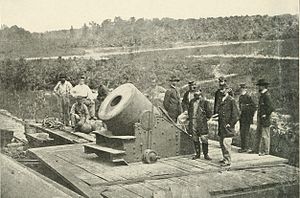Siege of Petersburg
| Siege of Petersburg | |||||||
|---|---|---|---|---|---|---|---|
| Part of the American Civil War | |||||||
 The "Dictator" siege mortar at Petersburg. In the foreground, the figure on the right is Brig. Gen. Henry J. Hunt, chief of artillery of the Army of the Potomac. |
|||||||
|
|||||||
| Belligerents | |||||||
|
|
|
||||||
| Commanders and leaders | |||||||
|
Ulysses S. Grant George G. Meade Benjamin F. Butler |
Robert E. Lee P. G. T. Beauregard |
||||||
| Units involved | |||||||
|
Army of Northern Virginia Department of North Carolina and Southern Virginia |
|||||||
| Strength | |||||||
| 67,000–125,000 | ∼ 52,000 | ||||||
| Casualties and losses | |||||||
| 42,000 (estimate) | 28,000 (estimate) | ||||||
The Richmond–Petersburg Campaign was a series of battles around Petersburg, Virginia, fought from June 9, 1864, to March 25, 1865, during the American Civil War. Although it is more popularly known as the Siege of Petersburg, it was not a classic military siege, in which a city is usually surrounded and all supply lines are cut off, nor was it strictly limited to actions against Petersburg. The campaign consisted of nine months of trench warfare in which Union forces commanded by Lt. Gen. Ulysses S. Grant assaulted Petersburg unsuccessfully and then constructed trench lines that eventually extended over 30 miles (48 km) from the eastern outskirts of Richmond, Virginia, to around the eastern and southern outskirts of Petersburg. Petersburg was crucial to the supply of Confederate Gen. Robert E. Lee's army and the Confederate capital of Richmond. Numerous raids were conducted and battles fought in attempts to cut off the Richmond and Petersburg Railroad. Many of these battles caused the lengthening of the trench lines, overloading dwindling Confederate resources.
Lee finally gave in to the pressure and abandoned both cities in April 1865, leading to his retreat and surrender at Appomattox Court House. The Siege of Petersburg foreshadowed the trench warfare that was common in World War I, earning it a prominent position in military history. It also featured the war's largest concentration of African American troops, who suffered heavy casualties at such engagements as the Battle of the Crater and Chaffin's Farm.
...
Wikipedia
